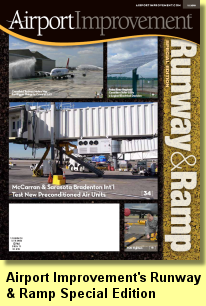 |
 |
Save Time. Save Money. Save Lives.By Mike Speidel
Sightline audits airfield marking systems as one of its primary services to airports. In my time spent evaluating markings - painted by both in-house crews and contractors - it is evident the majority of applicators have not been adequately trained to install them. The aviation industry trains its pilots and personnel on the ground to navigate safely, however no certification training exists for those installing the navigational system. Engineers, applicators, and inspectors need to be trained in order to specify, install and inspect a more effective marking system. With a marking certification training program in place, the aviation industry will save time, save money and save lives. Save TimeRepainting annually is inefficient when the markings do not require maintenance. However, it is quite common in the industry to repaint regardless of whether they are currently performing well. The decision about when to maintain markings is often subjective because they degrade slowly. Therefore the industry relies on the warm months as a cue to paint again.When the markings do require maintenance, they are often installed poorly leaving the airport with an ineffective, unsafe navigational environment - particularly during periods of darkness and/or low-visibility. Personnel trained to paint airfields according to the best practices in the Airfield Marking Handbook have a significantly better opportunity to install an effective product. Time allotted for painting operations would be reduced by identifying solely the markings requiring maintenance, and by limiting the potential for a poor application. Save MoneyMany airports opt to save money by omitting surface preparation from specifications, buying cheaper materials, etc. These decisions may help the immediate bottom line, but often end up costing more in the long run. Painting every year with cheaper, less effective, materials without performing surface preparation leads to paint build up. Eventually, the area will need remediation in the form of paint removal, which is a very slow and expensive process.The secret to a cost-effective marking system is longevity. Longer effective life from any given marking yields a lower cost per square foot. Achieving longer life from a marking system requires a different approach than what is commonly encountered in the industry. Tailored specifications and high quality materials selected unique to each airport combined with quality application and inspection are the necessary components for a marking system to be cost-effective. To realize these savings, those responsible for providing each of the components mentioned should be trained to do so. Save LivesMarkings are a vital part of an airport's navigational aid system. They provide an important function - to safely guide pilots, and ground vehicles, about the airfield. While there is no dispute over the importance of markings, there is a large disparity in the quality of markings among airports. Current practices have resulted in ineffective markings at the majority of airports. Most markings do not provide adequate situational awareness at night and in periods of low-visibility. Markings maintained repeatedly without surface preparation or paint removal accumulate thick layers that break apart creating foreign object debris (FOD) potential. Paint FOD can be mitigated with proper training and specifying appropriate solutions.The potential liability that markings represent is real. Conversely, the potential safety that high quality markings provide is also real. Improving our methodologies by training those responsible for specification, application, and inspection is the first step towards safer marking systems worldwide. That's how we can help save time, money and lives. |

 In September, Paul Bowers from
In September, Paul Bowers from